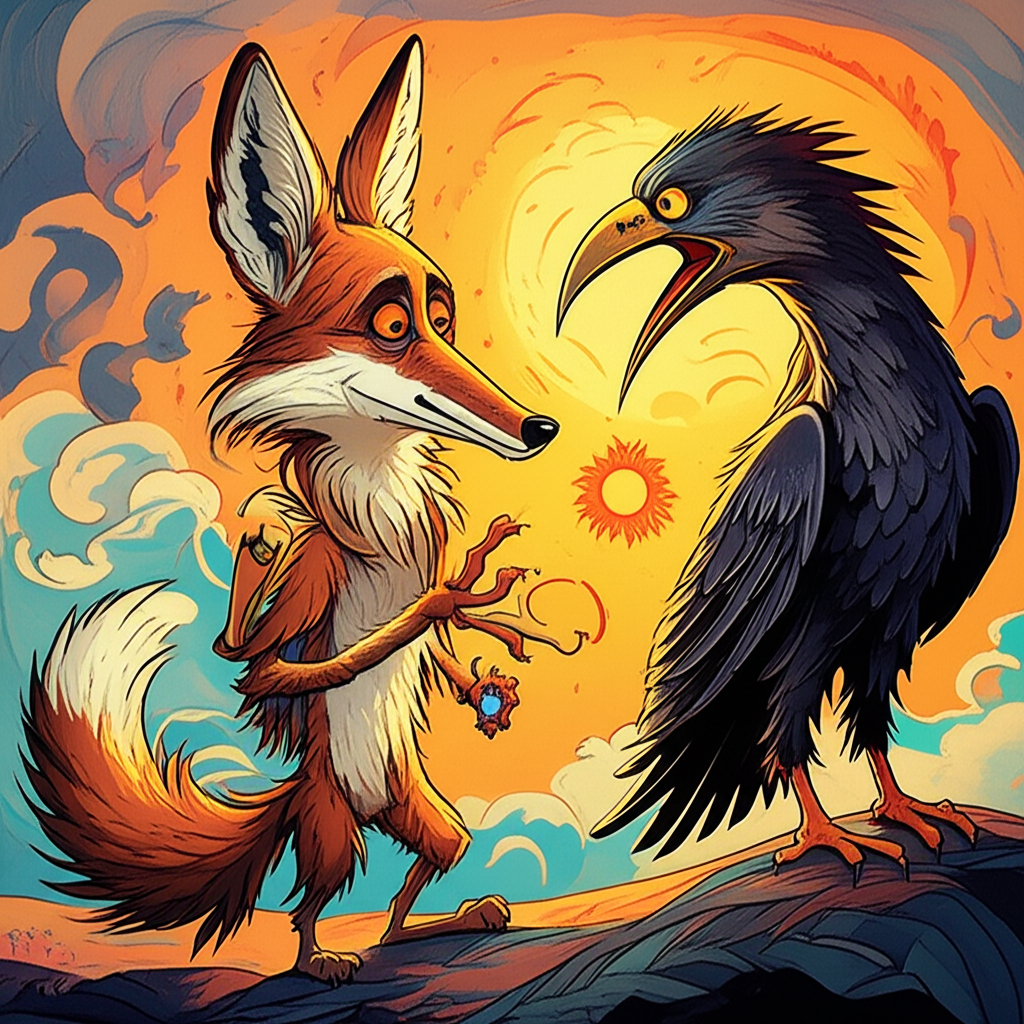
Introduction:
The story of Coyote, the Trickster, and Raven’s theft of the Sun is a cornerstone of the mythology of the Indigenous peoples of the Pacific Northwest Coast of North America. This region, stretching from southern Alaska down through British Columbia and into Washington state, is home to diverse cultures who, for countless generations, have passed down stories like this one. These are not historical accounts, nor are they religious scriptures in the strictest sense. Instead, they are traditional narratives, rich with symbolism and meaning, told by ancient people to explain the world around them, to teach lessons, and to entertain. We approach this tale today, not as a source of divine truth, but as a window into a fascinating and complex cultural heritage.
Origins and Cultural Background:
The era in which these myths flourished was a time of deep connection to the land and the sea. Life was dictated by the seasons, the bounty of the salmon runs, the abundance of forests, and the harsh realities of winter. The people of the Northwest Coast, including tribes like the Haida, Tlingit, Tsimshian, and Coast Salish, lived in villages along the coast, relying on elaborate fishing techniques, skillful woodworking, and intricate art forms. Their societies were often hierarchical, with complex social structures and a deep respect for ancestors and the natural world.
Their worldview was animistic, meaning they believed that spirits inhabited all things – animals, plants, rocks, and celestial bodies. The world was not a sterile, scientific landscape, but a vibrant tapestry of interconnected beings, constantly interacting and influencing each other. Storytelling was central to their lives, serving as a means of preserving history, transmitting knowledge, and reinforcing social values. The myths provided explanations for the creation of the world, the origins of the sun, moon, and stars, and the characteristics of the animals that shared their environment. They weren’t just stories; they were a way of understanding the universe and their place within it.
Character/Creature Description:
Coyote: The Trickster is a ubiquitous figure in the folklore of many Native American cultures. He is often depicted as a clever, cunning, and sometimes foolish character. Coyote is a shapeshifter, capable of taking on various forms, often appearing as a human or a coyote. He is known for his mischievousness, his insatiable appetite, and his tendency to break rules. Despite his flaws, Coyote often plays a vital role in the creation of the world, teaching lessons (often unintentionally), and bringing about change. He embodies the chaotic and unpredictable aspects of life, representing both the potential for good and the risk of chaos.
Raven: Raven is another prominent figure in the mythology of the Northwest Coast. Unlike Coyote, Raven is often depicted as a creator figure, a bringer of light and order. He is clever, resourceful, and capable of powerful magic. Raven is frequently associated with the sun, the moon, and the stars. He is also a shape-shifter, sometimes appearing as a giant black bird, sometimes as a man. He is a complex character, embodying both wisdom and trickery, and often using his cunning to help humanity.
Main Story / Narrative Retelling:
In the beginning, the world was shrouded in darkness. The sun, the moon, and the stars were hidden away by a selfish and miserly old man who kept them locked in cedar boxes inside his longhouse. This old man, a powerful figure, guarded his treasures jealously, refusing to share their light with the world. The people lived in perpetual twilight, stumbling through life in a perpetual haze.
Raven, a being of immense power and cunning, longed to bring light to the world. He knew the sun was the source of warmth and life, and without it, the world would remain cold and desolate. He devised a plan, a daring scheme to steal the sun.
First, Raven transformed himself into a small, insignificant pine needle. He floated on the water near the old man’s longhouse, eventually being swallowed by the old man’s daughter. Once inside her, Raven took human form, and was soon born as a human child. The old man, delighted with his new grandchild, doted on him and lavished him with attention.
As the child grew, he was allowed to play with the precious treasures. One day, while the old man was distracted, the young Raven, using his trickster nature, asked to play with the sun. The old man, unable to deny his beloved grandchild, opened the box, and Raven quickly seized the sun. He flew through the smoke hole, the sun’s radiant light illuminating the world for the first time.
Next, Raven stole the moon. Repeating his trick, he was given permission to play with the moon, and when he had the chance, he escaped through the smoke hole with the moon in his grasp.
Then, Raven stole the stars, again using the distraction of the old man. The old man, enraged and heartbroken, chased after Raven, but it was too late. The sun, the moon, and the stars were now scattered across the sky, bringing light and order to the world.
Raven, now transformed into his full raven form, flew across the sky, bringing daylight and warmth to the world. He had succeeded in his mission, transforming the world from darkness to light.
Symbolism and Meaning:
This story is rich with symbolism. The darkness before Raven’s theft represents a state of ignorance, coldness, and lack of knowledge. The miserly old man embodies selfishness and the hoarding of knowledge and power. Raven’s actions represent the bringing of enlightenment, the sharing of knowledge, and the beginning of civilization. The sun, the moon, and the stars represent knowledge, understanding, and the ability to perceive the world in a clear and structured way.
The myth highlights the value of resourcefulness, cunning, and the importance of challenging authority, even when that authority is powerful and seemingly unyielding. It also speaks to the transformative power of knowledge and the responsibility that comes with sharing it. The story also shows the trickster nature of the Raven, using tricks and disguise to achieve his aims.
Modern Perspective:
Today, the story of Raven stealing the Sun, and the role of Coyote, continues to be a vibrant part of Northwest Coast culture. It is told in books, performed in plays, and featured in artwork and film. The images of Raven, the Sun, and Coyote adorn totem poles, masks, and regalia. The story is used in educational settings to teach children about their cultural heritage and to promote an appreciation for the values and beliefs of their ancestors. In the broader context of literature, mythology, and cultural studies, the story is analyzed for its symbolic meanings, its exploration of human nature, and its reflection of the relationship between humans and the natural world.
Conclusion:
The tale of Coyote and Raven is more than just a story; it is a cultural touchstone. It is a testament to the ingenuity, creativity, and spiritual depth of the Indigenous peoples of the Northwest Coast. While we, as Muslims, recognize that only Allah is the true Creator and Sustainer, we can still appreciate the richness and complexity of this cultural heritage. We can be inspired by the imagination and storytelling traditions of these ancient people. It is through these stories that we gain a deeper understanding of the human experience, the beauty of cultural diversity, and the enduring power of myth. We acknowledge and respect the cultural heritage, the imagination, and the storytelling tradition of this group of people.





